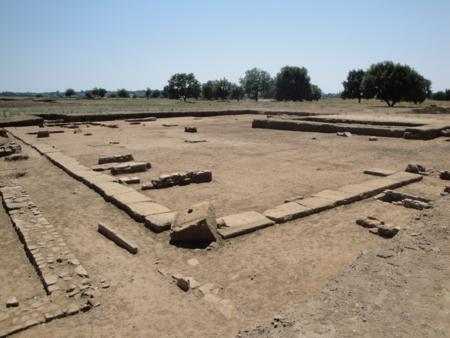 |
Capital of Hollow (or Coele) Elis, on the left bank of
the Peneus river, having Cyllene as a port. Diodorus and
Strabo telling that Elis was built after the Persian
wars, around 470 BC, and Pausanias mentions that Oxylus
the Aetolian gathered there the inhabitants of the
nearby towns and created the town at the age of the
Dorian invasion. Homer mentions aboout Elin, but it's
believed that this is the country and not the city. In
historical times, Elis was a great city with splendid
buildings and artistic works.
|
|

The
large gymnasium was called Xystos, and had tall
plane-trees inside, private area for the runners and pentathlon athlets, another
site called Plethrion where the Hellanodicae separated the athlets, altars of
the Idaean Heracles - who was surnamed as Parastates (assistant) also - altars
of Eros and Anteros, of Demeter and Persephone, and the cenotaph of Achilles.
There was a smaller precinct
of the gymnasium, which called Tetragonon (square), and a third called Maltho,
because it had a soft ground. Other buildings were the bouleuterion (parliament)
of the Eleans, the Lalichmion (named after the man who built it), where speeches
where recited and various writings were read, the temple of Philomirax Artemis,
where lead there the road of the Silence, the Hellanodicaeon, where lived there
for eleven months those who were elected as the Hellanodicae (umpires), to learn
from the nomophylakes (law-guardians) what they should do during the games, the
Hippodrome or market, with its many stoas, the temples and statues of Apollo
Acesius, the temple of the Sun and Moon, the temple of Charites, of Eros, of
Silenus, the tomb of Oxylus with a temple shape, and a building the so-called
sixteen women's who weaved the Hera's veil.
Near the market existed a
temple which was dedicated to the Roman kings, another temple dedicated to
Aphrodite (Ourania - Pandemos), a precinct and a temlple of Hades, a temple of
Tyche (fortune), a temple and a statue of beardless Poseidon, a theater and a
temple of Dionysus, etc.
In the citadel of Elis was the
temple of Athena with an alectryon on her head, a work of Pheidias of gold and
ivory. Elis was unwalled as being a sacred city of the Olympian Zeus. Only the
citadel was fortificated. Ruins of Elis found by the Austrian Archaeological
School of Athens during the years 1910-14.
|




